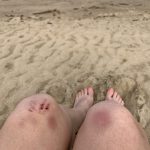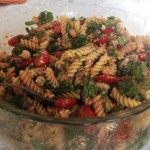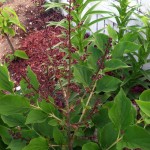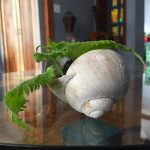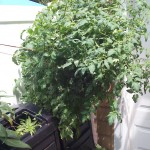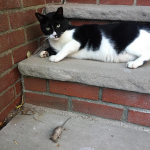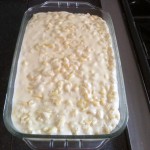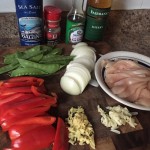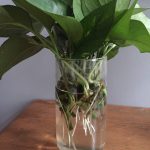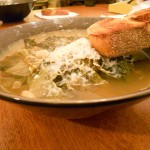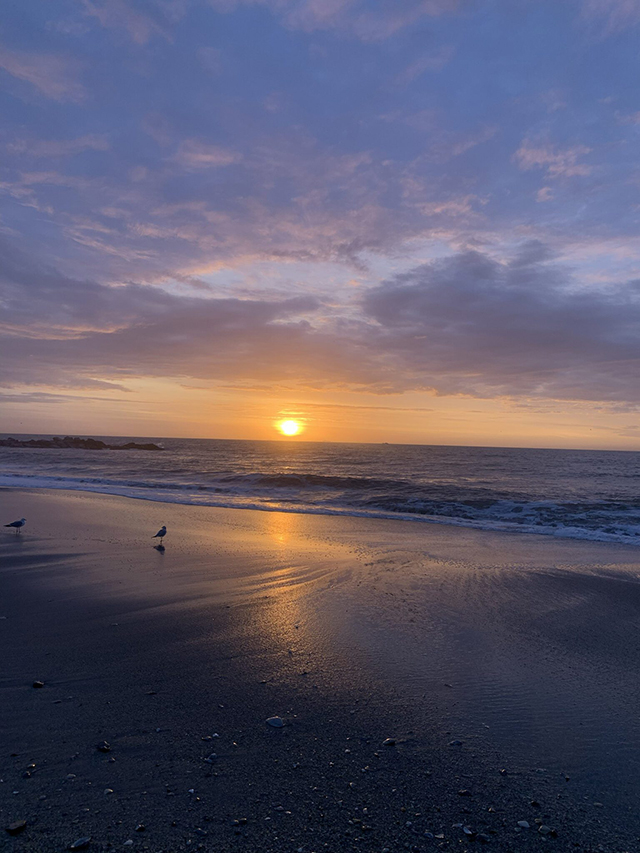
I hadn’t surfed in three weeks. It felt wrong. I didn’t like it. It wasn’t even the cold that held me back. I accepted a long-term freelance gig that’s been all-consuming. It’s the type of schedule where you fall behind on life – laundry, making the bed, no food in the fridge, Christmas decorations all over the living room floor. I’ve skipped needed showers, skipped brushing my hair (well, in fairness I rarely brush my hair), and skipped writing my column (eek). I’ve been living on a screen, on Slack, and in InDesign.
Last Sunday it was sunny with no wind and small waves. That met my criteria. I went surfing with the intention of trying out my new winter gear.
It took me forever to put my 5/4 wetsuit on. I felt a bit claustrophobic. The most challenging part was getting the gloves on. I was bending and cursing and laughing and sweating. My concern about being cold dissipated after the 40-minute struggle in rubber. The wetsuit sleeve is supposed to go over the glove. Less water enters in this way. I gave up on the last glove. Luckily, I flagged down my friends Kaitlyn and John who I saw on the boardwalk and they helped me.
I felt like a fish out of water or like the Marshmallow Man from Ghostbusters. It’s hard to hold the board with mitten gloves. I had to carry it on my head.
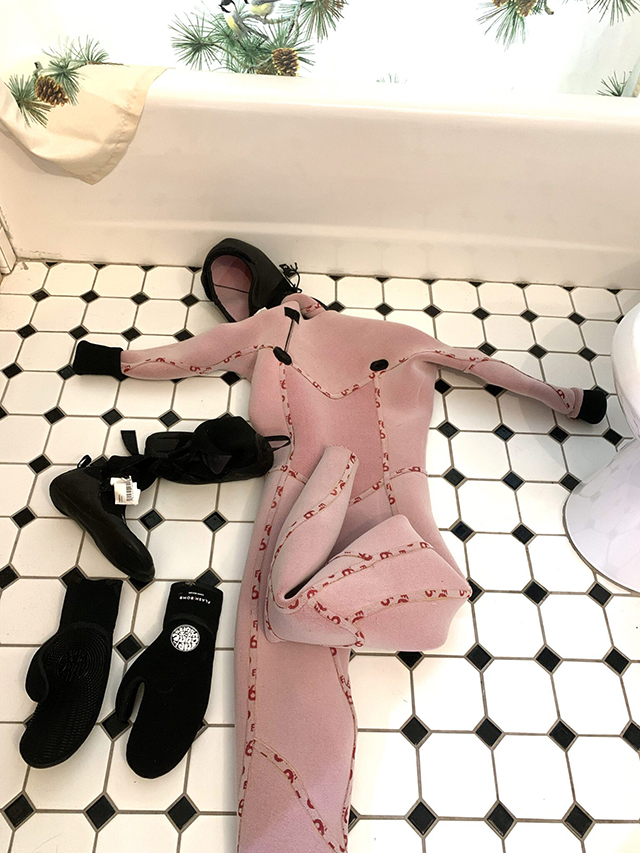
Entering the water is a strange sensation. You expect to feel the shocking cold but you don’t. I was immune. The constraints of the wetsuit disappeared. I transformed. I was a buoyant, happy, cartoon crab. Cartoon because it’s so silly to be wrapped up head to toe in thick rubber. This is what it’s like to have an exoskeleton, to be an ocean animal, I thought. But my outer protection is 5 millimeters of neoprene.
My hands in mittens were now claw-fins. I was paddling through the break faster and stronger than ever before. Though, I remembered to conserve my energy because my arms were a heavy exoskeleton. I couldn’t hear. My head was hooded. But it was ok! I just needed sight, to see the waves forming on the horizon. Finally, after acclimating to my new form, I fly out of the sea like there’s a bass chasing me and I escape onto the wave, riding it to the safety of the shore.
The winter sunrise is especially colorful, yet the beach feels lonely and quiet. It’s the type of loneliness that I need right now. The solitude before the work that waits for me back on land.
Follow me for the day-to-day on Instagram –@theglorifiedtomato.
Since the first week of November the deliciously dynamic duo La Brotheria, has been open at the 97th Street Concession. La Fruteria (@lafruterianyc) and Brothers (@brothersrockaway) joined kitchens, serving us breakfast, lunch, and a diverse taste with guest pop-up dinners all month. It’s been a joy for so many of us. As we all know, winters can be difficult in Rockaway… you know, the quick shift from the lively, sunny, summer to chilly, unconsolable nothingness. Personally, having La Brotheria as a gathering place to meet friends and enjoy great food has been so wonderful.
This is the final weekend of La Brotheria and it’s not to be missed. Friday – Sunday mornings enjoy breakfast, smoothies, and coffee till 2 p.m. If you haven’t had the ricotta toast yet, get that! Friday night is Burgers with Zak Daddy, The burgers are juicy and the fries are hand-cut, need I say more?
And Saturday night (Dec 3rd), will be the last supper. La Brotheria is hosting Chef Luca and Chef Silvia of the very popular and delicious Italian, Brooklyn restaurant LaRina Pastificio (@larinabrooklyn). Enjoy a 4-course decadent meal with options of pizza, polenta, fried mushrooms, smoked spaghetti aglio e olio, porchetta, and more. For the full menu see – @brothersrockawayand reserve via Instagram DM now. Spots are very limited.
Erosika (@3rosika) will be setting the mood with a musical performance! There’s plenty happening at the 97th street concession all weekend so show your support, eat, and enjoy the ocean views and the people around you.
Thank you to Rockaway Beach Bazaar for extending the concession season, installing winter-proof doors, and providing an all-around cool vibe for us. Thank you La Brotheria – Zak Krieger, Sarah Peltier, Matt Webster, Phil Rodriguez, Erika Barrett and Rachel Krieger.
Please support two of our favorite local eateries and let’s finish off in the right fashion. My hope is that with their success, we will see them again before the start of next summer.
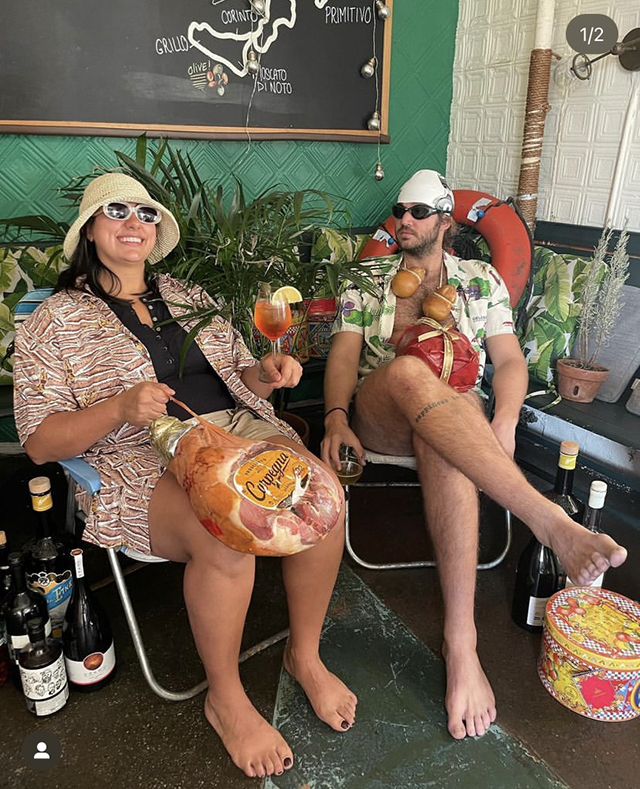
Chef Luca and Chef-Silvia of LaRina Pastificio

by Paula D.
on November 28, 2022 12:37 pm in Plants
The crisp air reminds me of a fall day when I was in grammar school. We went outside and collected leaves from the field next to the playground. My classmates and I were scattered about. I remember feeling anxious, wanting to find the best and brightest ones before everyone else did. I was on a color collection mission. My next recollection is staring at my precious assortment of orange and red leaves on an off-white table. I don’t particularly remember what the art project entailed or what I made. I do recall my art teacher explaining that she would laminate our final creations and I thought that was cool. I know I enjoyed the project and process very much.
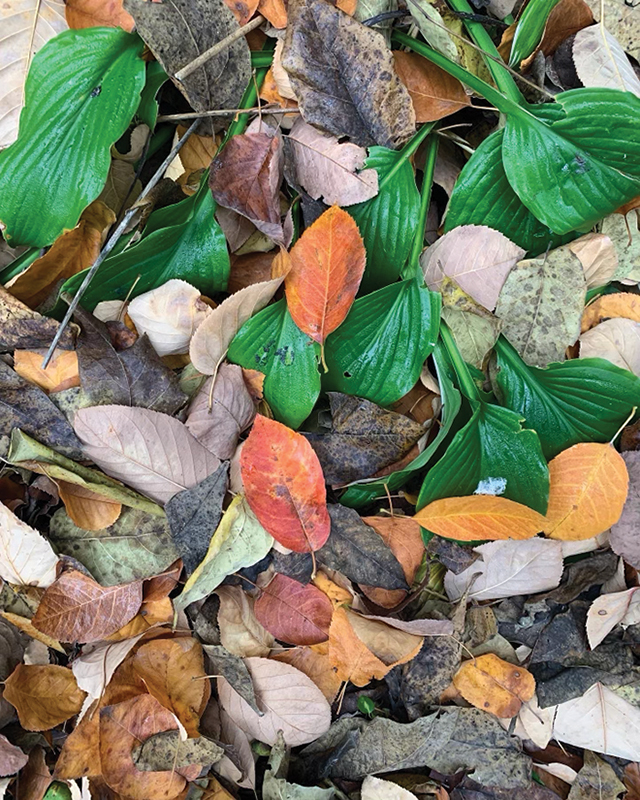
Fallen leaves over winter provide an ecosystem for important insects such as bumblebees
I still look down at the leaves under my shoes. The best moments are when I’m running errands, distracted and then the brightness of a very special leaf catches my eye. And I pause to appreciate its vivid beauty. The multi-color patterns and intricate lines are pretty amazing when you look closely. But they do not last. Maybe their inevitable decay is why they are so precious. Like all things of nature – nothing gold can stay.
Leaves change color as the length of the night increases and they receive less chlorophyll. With this, a biochemical process begins which determines the color changes that produce the beautiful hues of fall foliage.
It may be tempting to clean up the yard on a sunny autumn day, raking, blowing, and bagging up the leaves. But it is best to leave nature’s natural process alone. Butterflies, bees, moths, spiders, and other pollinators and insects rely on the bed of fallen leaves as their food source and ecosystem over winter. And yes, I said bees… newly mated bumblebee queens hibernate in small nests underground – about 3-5 inches below the soil, protected by leaves. They emerge in the spring to find the perfect location to start their new hive family. And the queen does this all on her own until her first brood is hatched. Queen’s rule! I hope this bumblebee fact makes you think twice about raking the yard this weekend.
Other benefits to leaving the leaves:
- Less work.
- Leaves form a natural mulch that enriches the soil. I wrote a column about it a few months ago, check it out… Mulch Grows Soil.
- Use some to make lovely seasonal artwork for yourself and/or to educate your children.
My friend Jodi Jordan Mulvanerty is a Pre-K teacher. She was inspired by the fall foliage and made collages with her students. Get creative with the colorful nature around you. If you make artwork using leaves, tag me on Instagram (@theglorifiedtomato), I’d love to share the work on my feed!
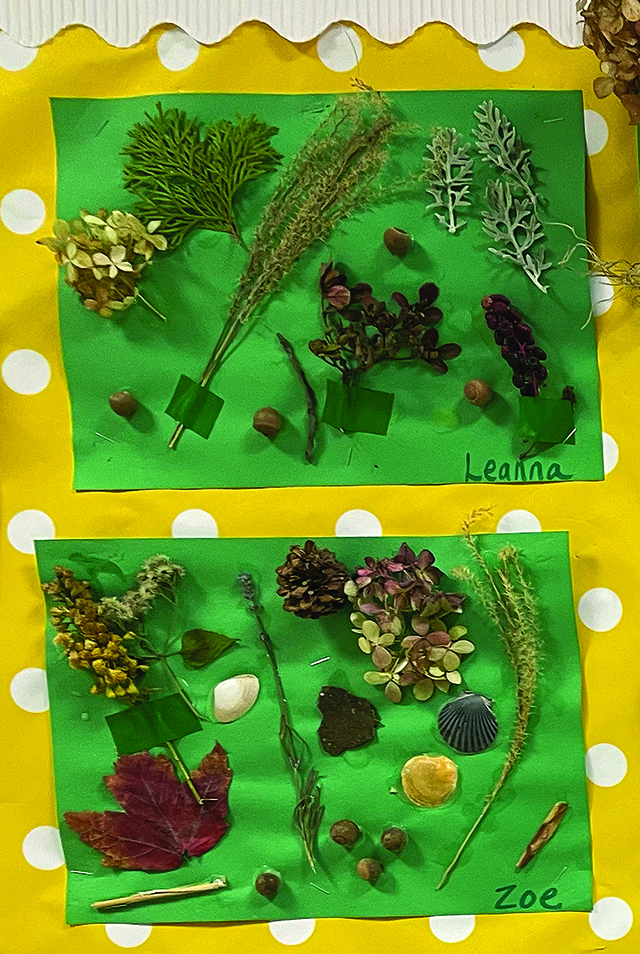

Mckenzie Dowler gets a photo with Skelly after a surf sesh.
It was late at night. I was in bed looking on craigslist in hopes of finding the elusive 12 foot Home Depot Skeleton on the black market. No luck. But then, like a magic rabbit popping out of a velvet hat, there he was, back in stock on homedepot.com. Clicking “purchase” gave me a sensational rush of power. I hit the freedom button.
It’s not often that a big box store gives society a big communal gift. There is something culturally significant about the 12 ft skeleton (dubbed Skelly). Maybe it resonates with us because it’s a ridiculous statement of our consumer culture; or it echoes the thin sadness on our faces that we try so hard to bury inside of ourselves; or perhaps its massive presence gives us strength; or maybe it simply brings a smile to your child’s face. The larger-than-life, high-density polyethylene yard decoration was first issued in 2020. It was enormously popular but then disappeared during Covid. This year, Skelly reemerged and it has been fervently sought after.
I kept checking my order status. I had very little time before the big day. And then I thought, “How the hell am I putting this thing together?” I finally got a notification the Tuesday before Halloween, “Your order is ready for pick up.” I drive to Home Depot in a frenzy of excitement. Four construction dudes notice my alarm as I’m looking at the gigantic box. I had know clue how I was getting it in the car. One of the guys said it would never fit in my Chrysler Pacifica and I should hire one of those vans in the parking lot. As the men debated, an older gentleman, a Home Depot employee named Bruno said, “Let me help you to the car, we’ll figure it out.”
The construction guys were right though. The box didn’t fit but Bruno had an idea. We took the skeleton out of the box and shoved the body parts in my car. I drive home smiling ear to ear with the bones in the back seat.
My friend Tom was happy (I think) to help me assemble the skeleton. If you know the basics of anatomy, the Skelly isn’t complicated to set up. You just need one strong, willing person to assist. My friend Kaori, who doesn’t like Halloween (for various reasons I will not disclose), recognized the importance of the moment and documented the process with video.
What I thought would be a silly, temporary “happy fix” for me, turned into something genuinely special. My friends and neighbors freaked out with excitement! They embraced Skelly. The whole town was on my side. The towering bones connected us in community. Everyone wanted a picture with him. My instagram blew up! The kids’ eyes lit up with wonder, almost as bright as Skelly’s artificial, animated LCD eyeballs. I’d see people I didn’t know outside in the garden getting their photo ops too. I’m thrilled everyone embraced my impulse purchase. Thank you for making this Halloween so special for me. I wholeheartedly appreciate all of you.
To see dozens of photos of your neighbors with Skelly, visit my Instagram page – @theglorifiedtomato

Baby Arthur Yoda, Patsy and Laura Nesci Carroll get thier family photo in!

Susannah Ray, Kristi Dickerson, Collin Ackers, Bridget Klapinski.















